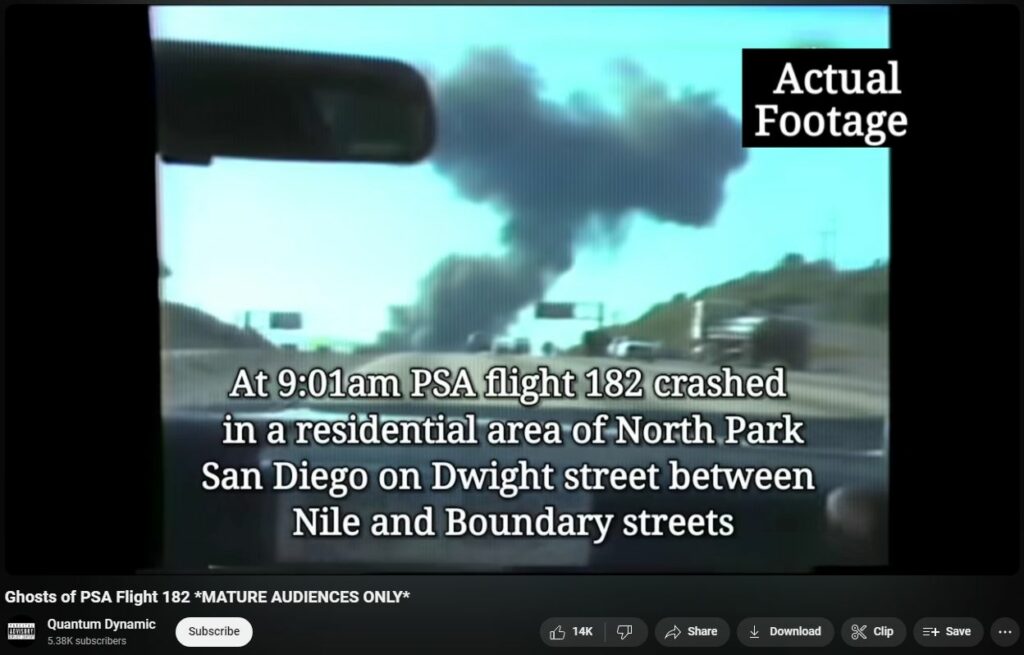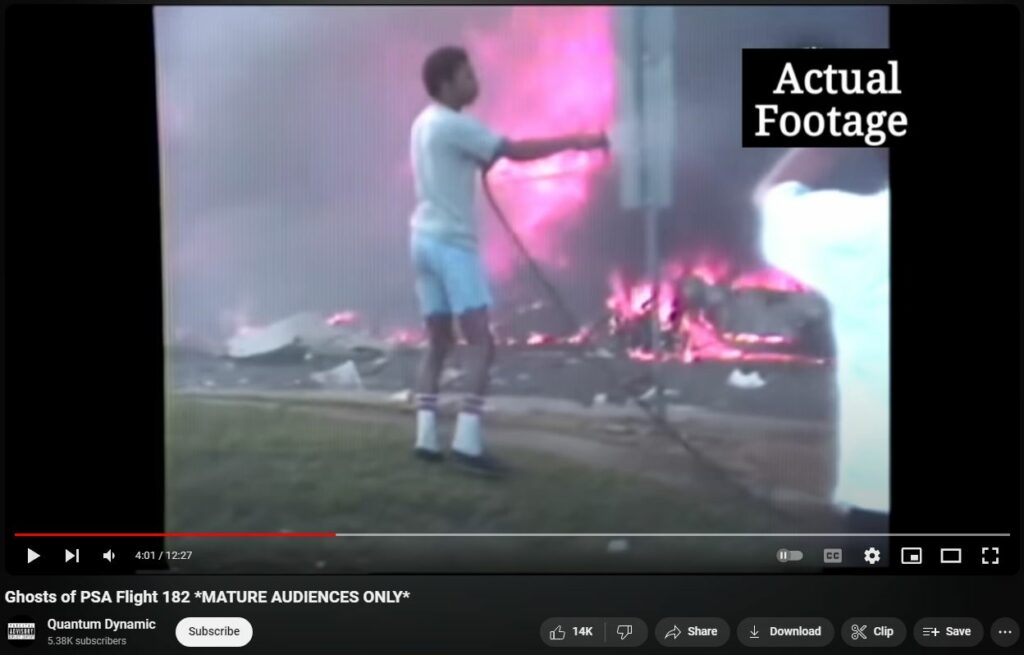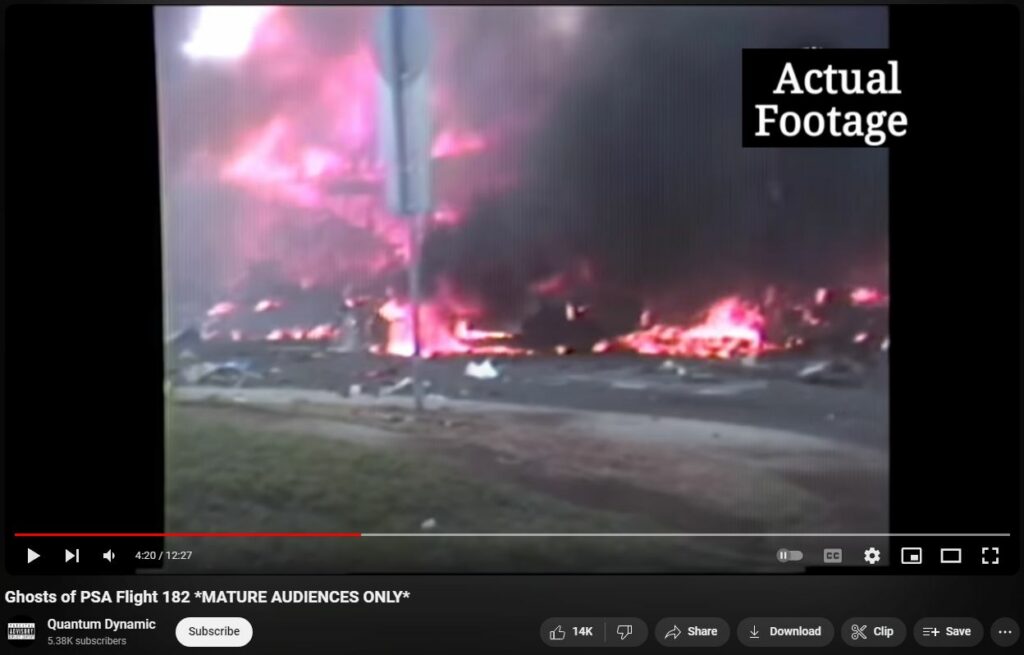What a Real Plane Crash Looks Like
Category /category/plane-crash
https://en.wikipedia.org/wiki/Pacific_Southwest_Airlines_Flight_182
Jet fuel burning in any amount and under any circumstances (particularly in open-air conditions!) can not possible melt steel or even aluminum. It never even weakens let alone melts the jet engines perfectly-intensely burning it. We have all been duped, stooged, totally and completely lied-to regarding 911 WTC tower collapsing (…due to structural failure mostly caused by heat from jet fuel…); all of Flight 93 vanishing into soft earth baloney; and all of the Pentagon pentacon.
Ghosts of PSA Flight 182 MATURE AUDIENCES ONLY – YouTube
PSA 182 at Dwight and Boundary, San Diego. 25 Sep 1978
Large debris field. Intense fire. Yet black soot galore; nothing burned down into white ash; steel and even aluminum not melted down into nothingness!
The Crash of PSA Flight 182: Debunking the Myths Surrounding Jet Fuel and Structural Melting
The crash of PSA Flight 182 on September 25, 1978, remains one of the deadliest aviation accidents in U.S. history. As we examine the aftermath of this tragic event, it is crucial to address common misconceptions about the capabilities of jet fuel and its effects on aircraft materials. By understanding the properties of aluminum and steel, and contrasting the PSA 182 crash with the events surrounding Flight 93 in Shanksville, we can gain a clearer perspective on the true nature of these incidents.
The Aluminum Fuselage and Steel Structures
PSA Flight 182, a Boeing 727, was primarily constructed from aluminum alloys for its fuselage, with steel used in critical structural components. Despite the catastrophic nature of the crash, much of the wreckage was not reduced to calcinated white ash. This observation alone contradicts the notion that jet fuel can cause the complete combustion and disintegration of an aircraft.
Melting Temperatures and Combustion
To understand why the aircraft’s materials did not turn to ash, we need to examine the melting points of the materials involved:
- Aluminum: Melting point at approximately 660°C (1220°F)
- Steel: Melting point at approximately 1370-1510°C (2500-2750°F)
Jet fuel, primarily composed of kerosene, burns at a maximum temperature of around 980-1500°C (1796-2732°F) under optimal conditions. However, in an open-air environment, such as an aircraft crash, the temperatures are significantly lower due to the lack of controlled conditions like those found in a blast furnace. Typically, jet fuel burns at around 980°C (1796°F) in open air.
Open-Air Fires vs. Blast Furnaces
Open-air fires, such as those resulting from a plane crash, burn with a relatively cooler, black, and sooty flame compared to the intense, controlled environment of a blowtorch or blast furnace. This cooler burn is insufficient to reach the melting points of steel and aluminum. To achieve the necessary temperatures for melting steel, an environment like a blast furnace is required, which can sustain temperatures well above those produced by burning jet fuel.
The PSA 182 Crash Aftermath
In the case of PSA Flight 182, the post-crash fire was unable to reach the melting temperatures of the aircraft’s materials. This explains why significant portions of the aluminum fuselage and steel structures remained largely unburnt and recognizable. The fire, although intense, could not sustain the necessary heat to melt or cremate these materials entirely.
Jet Fuel Cannot Melt Steel
The claim that jet fuel can melt steel has been widely debunked by experts. As demonstrated, the maximum temperature at which jet fuel burns in open air is insufficient to reach the melting point of steel. In both the PSA 182 and Flight 93 crashes, while fires caused significant damage, they did not generate the necessary heat to melt or completely cremate the aircraft structures.
Conclusion
The crash of PSA Flight 182 serves as a poignant reminder of the devastating power of aviation accidents. However, it also provides clear evidence against the myth that jet fuel can melt or cremate aircraft materials to the point of turning them into white ash. Understanding the science behind material properties, combustion, and fire behavior helps demystify these events and dispel misinformation. By comparing these principles to the Flight 93 crash, we further reinforce the understanding that while jet fuel fires are destructive, they are not capable of producing the extreme conditions required to melt steel or aluminum in an open-air environment.











































